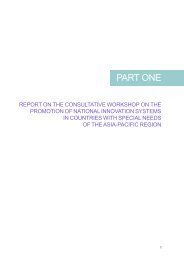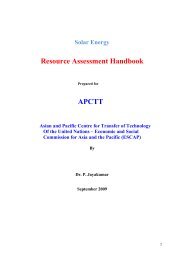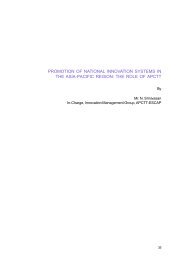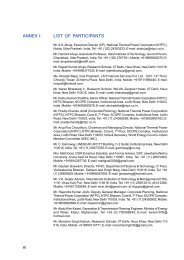With the entry of many private sector players – such as L&T-Mitsubishi, Bharat Forge-Alstom, BGR-Hitachi and JSW-Toshiba – into power generation equipment, thetechnology landscape is changing. Indigenous development of ultra-supercriticaltechnology has also begun, with a memorandum of understanding being signed betweenIGCAR, BHEL and NTPC to develop a power plant that uses the technology.D. Factors that hinder financingThe financial health of the off-takers is a major concern. For instance, several powerdistribution companies (Discoms) have precarious financial health and negative networth. Estimated accumulated losses of Discoms have run up to Rs 1,200 billion(US$23.6 billion), with a widening gap between average revenue realization (ARR) andaverage cost of supply (ACS). Furthermore, several major power projects may have toundergo financial restructuring in view of the extensive delays and associated costescalations. Areas that create difficulties in timely execution of projects include:• Land acquisition;• Firm power purchase agreements and off-take arrangements;• Fuel supply and transportation arrangements;• Choking transportation network; and• Undue delay in government clearances and evacuation arrangements.E. Current status and the way forwardAt present, aggressive lending is extremely selective, based on the project preparednessand the track record of project developers. Furthermore, power sector lending is nearingsaturation, with several banks breaching power sector exposure ceilings. As on 31March 2010, Indian banks and financing institutions had approximately Rs 3,300 billion(US$64.9 billion) power sector exposure.Debt to equity ratio has moved from 80:20 to 70:30, or even 60:40 in the case ofrenewable energy, and there is demand for higher upfront equity. Interest rates havehardened quite significantly during the past three years, and lenders are preferringshorter loan tenures, which are especially inadequate for hydro and renewable sectors.In addition, lenders demand collaterals other than project assets. All these factors areslowing down power sector investments.In the future, the financial performance of Discoms needs to be improved through:• Aggressively pursuing steps to reduce aggregate technical and commercial losses;• Undertaking steps to achieve tariff rationalization to recover the costs; and• Capitalization of Discoms and debt restructuring on priority basis.Coal mining needs to be stepped up and the implementation of the "Dedicated FreightCorridor" speeded up. Power projects, especially the major ones, need to be closelymonitored and the government needs to intervene proactively wherever needed to sortout matters. In addition, the government could expedite forest and environmentalclearances, as well as coal linkages and coal blocks. Take-out financing could befacilitated, with longer overall tenures that will increase debt servicing capacity ofprojects.122
ANNEX XIII:ADVANCED FOSSIL FUEL-BASED POWERGENERATION – FINANCING CHALLENGESByMr. Subhranshu PatnaikSenior Director (Partner)Deloitte Touche Tohmatsu India Private LimitedGurgaon, Haryana, IndiaA. Sector overviewThe deficit situation has improved in financial year 2010-11, partly on account of lowergrowth in demand and partly on account of underutilization of existing capacity andtransmission and distribution (T&D) losses (Table 3-12). During 2010-11 energy availabilityincreased by 5.6 per cent over the previous year and peak met increased by 6per cent. Peak demand has grown at an average rate of 7.1 per cent in the last fiveyears till 2009-10 (9 per cent in 2009-10). During the same period, energy consumptiongrew at an average of 6.3 per cent (10 per cent in FY 2006-07). In addition, the installedcapacity has grown at an average of 6.9 per cent in the last six years.Table 3-12: Power supply position in 2010-2011 (actual) and 2011-2012 (provisional)Component 2010-11 2011-12Energy (MU) Peak (MU) Energy (MU) Peak (MU)Requirement 861,591 122,287 933,741 136,193Availability 788,355 110,256 837,374 118,676Shortage 73,236 12,031 96,367 17,517Percentage 8.5 9.8 10.3 12.9In the Five-Year Plan (FYP) periods from 8 th to 10 th – i.e. 15 years – only 56,000 MWwas added. However, the 11 th FYP period achieved 54,000 MW. Private playerscontributed only 13 per cent to the capacity added in the 10 th FYP, but contributed to32 per cent addition till 2010-11 in the 11 th FYP. Delay in engineering, procurement andconstruction (EPC) was the main reason for failing to achieve the target in the 10 th FYPperiod. A shortfall of around 14,000 MW in the 11 th FYP period was on account of EPCdelay; coal availability has been the other reason for delay (likely to be more acute inthe 12 th FYP period).Guided by Section 63 of Electricity Act, 2003, the National Tariff Policy mandates theutilities to procure power through competitive bidding route. Before 6 January 2006,approval of power purchase agreement (PPA) was governed through individual StateRegulatory Acts, and was on a cost plus basis and offered a regulated return of only 14per cent. There was lack of clarity on the basis for approval of PPA and the scope fornegotiations on almost every cost item resulted in long-drawn processes. Since6 January 2006, however, the National Tariff Policy mandates that the power procurement123
- Page 1 and 2:
ADVANCES IN FOSSIL FUELTECHNOLOGIES
- Page 3 and 4:
ADVANCES IN FOSSIL FUELTECHNOLOGIES
- Page 5 and 6:
CONTENTSABBREVIATIONSiiiPART ONEREP
- Page 7 and 8:
ABBREVIATIONSAC : Alternating curre
- Page 9:
OECD : Organization for Economic Co
- Page 12 and 13:
IORGANIZATION OF THE WORKSHOPA. Bac
- Page 14 and 15:
D. Election of officersThe followin
- Page 16 and 17:
IIICONSIDERATION OF ISSUESA. Backgr
- Page 18 and 19:
emissions. Underground coal gasific
- Page 20 and 21:
800 MWe, a steam pressure of 300 kg
- Page 22 and 23:
• Materials development & manufac
- Page 24 and 25:
Figure 1-5: Strategy for commercial
- Page 26 and 27:
tonnes, the state-owned enterprise
- Page 28 and 29:
• Ensuring not just easy FDI entr
- Page 30 and 31:
MW ultra-supercritical units; and s
- Page 32 and 33:
the captive generation capacity) on
- Page 34 and 35:
and other financial institutions -
- Page 36 and 37:
and higher efficiency power generat
- Page 38 and 39:
energy technologies, which can enab
- Page 40 and 41:
• Such massive financial inputs c
- Page 43 and 44:
BASELINE REPORT ON FOSSIL FUEL TECH
- Page 45 and 46:
B. General R&D climate in the count
- Page 47 and 48:
a convenient way to envisage energy
- Page 49 and 50:
to mature and become more cost-comp
- Page 51 and 52:
emissions, at least relative to sin
- Page 53 and 54:
The Ministry of Power (MoP), which
- Page 55 and 56:
3. Bio-energyBio-energy, widely ava
- Page 57 and 58:
in such a canal will rotate at a lo
- Page 59 and 60:
in tackling climate change. A one p
- Page 61 and 62:
Advantages of supercritical plants
- Page 63 and 64:
existing power plants but also to b
- Page 65 and 66:
BASELINE REPORT ON FOREIGN DIRECT I
- Page 67 and 68:
CEA at 598 mt. This is mainly due t
- Page 69 and 70:
For India to maintain its momentum
- Page 71 and 72:
Table 2-5: Electricity generation t
- Page 73 and 74:
Growth, which submitted its interim
- Page 75 and 76:
3. Future challengesThe future chal
- Page 77 and 78:
development worked out. Public-priv
- Page 79 and 80:
Linking FDI to technology transferI
- Page 81 and 82: The total requirement of fund durin
- Page 83 and 84: Funding from multilateral agenciesM
- Page 85 and 86: cooperation will be essential in so
- Page 87: Planning Commission, Government of
- Page 90 and 91: ANNEX I:LIST OF PARTICIPANTSMr. A.K
- Page 92 and 93: Mr. S.C. Shrivastava, Joint Chief (
- Page 94 and 95: ANNEX II:PROGRAMME6 June 2012, Wedn
- Page 96 and 97: ANNEX III:AN OVERVIEW OF ADVANCED F
- Page 98 and 99: • Technology solutions are also v
- Page 100 and 101: Table 3-5: Improvement in cycle eff
- Page 102 and 103: • No liquid effluent formation;
- Page 104 and 105: Figure 3-5: Advancement of gas turb
- Page 106 and 107: Figure 3-8: Goal 2 - New clean tech
- Page 108 and 109: Compared with conventional power pl
- Page 110 and 111: Figure 3-14: Thermax coal gasificat
- Page 112 and 113: ANNEX VII:GE ENERGY AND ADVANCED FO
- Page 114 and 115: ANNEX VIII:SWOT ANALYSIS OF FOSSIL
- Page 116 and 117: By 2035, cumulative CO 2emissions f
- Page 118 and 119: • Falling prices of renewable ene
- Page 120 and 121: Figure 3-20: New advanced coal powe
- Page 122 and 123: ANNEX X:ENERGY CONSERVATION: ERDA
- Page 124 and 125: Table 3-11: Energy cost and intensi
- Page 126 and 127: 300Figure 3-23: Trends in coal use
- Page 128 and 129: C. Gaps in coal use efficiencyFigur
- Page 130 and 131: ANNEX XII:FINANCING OF THE POWER SE
- Page 134 and 135: for future requirements should be t
- Page 136 and 137: Short supply of coal has started af
- Page 138: Figure 3-35: Life-cycle of technolo







